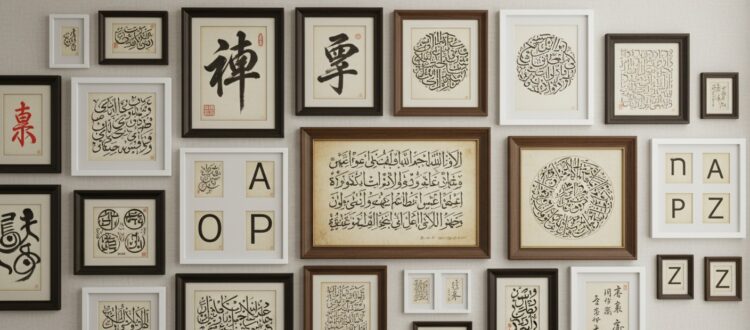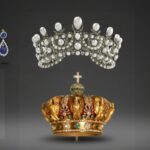Calligraphy and Art: The Timeless Allure of Elegant Strokes
Have you ever felt mesmerised by artwork featuring elegant strokes of brush, words written stylishly or a perfectly formed letter? Then you have stumbled upon the beautiful art of calligraphy. Imagine letters flowing like elegant rivers, dancing with a rhythm only they can hear, forming art that captivates you. That is the magic of calligraphy, equal parts craftsmanship and creativity, merging writing with artistic expression.
In a world filled with texts, emojis, and voice messages, when was the last time you put ink to paper? Not the hurried scribble of a grocery list but deliberate strokes that evoke emotion, that transform words into poetry. From wedding invites that wow guests to elegant calligraphy wall art that transforms a room, calligraphy artworks are everywhere.
Whether you’re an art enthusiast, a home decor lover, or simply someone enchanted by visual beauty, calligraphy art has a fascinating story to tell. Today, let’s explore the origins of calligraphy, diverse styles, and tips on how to bring its elegance into your own life.

What is Calligraphy?

The word calligraphy comes from the Greek words ‘kallos’, meaning ‘beauty’ and ‘graaphien‘, which translates to ‘writing’. At its heart, it means “the art of beautiful writing.”
Calligraphy is an ancient manner of expressing thoughts and ideas through elegant scripts.
The art of calligraphy can be found in various cultures and traditions, including Chinese, Japanese, Arabic, Persian, Western, and, of course, Indian.
Calligraphy and Art
At its core, calligraphy is art, but it’s a unique form of it. Calligraphy can be called as the art of language. Unlike traditional paintings, which contain figurative imagery, calligraphy transforms language into art. Just as a painter expresses feelings through colour, a calligrapher conveys emotions through the weight of a brushstroke or the curve of a letter.
Also Read: Explore Various Art Media
The Allure of Calligraphy Paintings
Why are people drawn to calligraphy paintings so much?
- Elegance & Luxury: The flowing lines instantly add sophistication.
- Cultural Depth: Calligraphy connects us to centuries-old traditions.
- Personalization: Names, quotes, or scriptures can be turned into custom artwork.
- Timeless Appeal: Unlike trendy décor, calligraphy art never goes out of style.
- Minimalism: Even a single word, written with sweeping strokes on a canvas, can feel powerful enough to transform a space.
Origins of Calligraphy: How it Developed
The history of calligraphy can be traced back thousands of years, since it’s connected to the origin of writing itself! While the styles vary, the intention has always been clear: to turn writing into an art form.
Here is how calligraphy as an art form developed across various cultures and traditions:
- Chinese Calligraphy:
Calligraphy’s origin is rooted in ancient China, with its practice on bones and shells dating back to the Shang Dynasty.
Dating back over 2,000 years, it emphasizes brushwork, balance, and spiritual harmony.
- Japanese Calligraphy:
Japanese calligraphy, or Shodo (“the way of writing”), is a traditional art form using brush and ink to create characters with expressive strokes and variations in width.
- Greek Calligraphy:
Greek calligraphy uses the letters of the Greek alphabet, with distinct forms for uppercase (majuscule) and lowercase (minuscule) letters.
- Roman Calligraphy:
Calligraphy in the context of the Latin alphabet originated in ancient Rome around 600 BCE with the introduction of the Latin script.
- Arabic Calligraphy:
Arabic calligraphy was originally a tool for communication, but with time, it began to be used in architecture, decoration and coin design.
- Indian Calligraphy:
The history of Indian calligraphy is rich and complex. The history of Indian calligraphy can be traced back to the ancient Indus Valley Civilization, where early writing systems such as the Indus script were used.
- Western Calligraphy:
From medieval illuminated manuscripts to Gothic lettering, it shaped European art and literature. Western calligraphy means any lettering style that uses the Latin alphabet.
Diverse Styles of Calligraphy
The world of calligraphy is huge, with various styles and types prevailing. Let us look at the different styles & types of calligraphy:
- Western Calligraphy:

- Uncial
This ancient style originated in Rome. It is a rounded and often majuscule (all capital letters) script.
- Blackletter (Gothic)
A heavy, angular, and compressed script prevalent in medieval Europe, often associated with old manuscripts and architectural lettering.
- Copperplate
Emerging in the 18th century, Copperplate is known for its graceful and flowing curves.
- Spencerian
A lighter, more fluid, and graceful hand than Copperplate, this style was popular in 19th-century America.
- Italic
Italic is a slanted script that originated in Italy during the Renaissance.
- East Asian Calligraphy (Chinese, Japanese, Korean, etc.)

Characterized by the use of brushes, ink, and absorbent paper, there is emphasis on the flow, balance, and energy of the strokes.
- Brush Calligraphy
This dynamic form uses brushes of various sizes, which allows for expressive and varied strokes.
- Standard Script or ‘Kaishu’
A square and regular style, it’s the form children learn to read and write in.
- Gyosho
Gyosho is a Japanese and Chinese semi-cursive calligraphy style that blends the precision of the square script with the speed and fluidity of a cursive style.
- Japanese Shodo
The practice of Japanese calligraphy, or “the way of writing,” includes the same styles found in China, adapted in a distinct art form.
- Korean Seoye
“The art of writing” is Korea’s tradition of brush calligraphy, which also draws on the Chinese character system and the brush art form.
- Islamic Calligraphy
A rich tradition with numerous styles, many based on the proportions of the alif (the first letter of the Arabic alphabet).
- Kufic
An early, angular, and monumental script, often found in early Qurans and architectural inscriptions
- Naskh:
A rounded, legible script that became popular for copying the Quran and everyday writing.
- Thuluth
A grand and ornate script, often used for headings and monumental inscriptions.
- Diwani
A flowing, decorative, and highly stylized script developed during the Ottoman Empire, characterized by its closely connected letters and upward flourishes.
Calligraphy for Home Décor: Tips & Ideas
Calligraphy is not restricted to ancient manuscripts or collectible art pieces. Today, it is a major lifestyle trend, enriching modern living spaces with elegance. Here are some decor tips to bring calligraphy into your home or workspace:
- Wall Art & Canvases: Hang calligraphy paintings featuring inspiring quotes, poetry, or single powerful words.
- Wedding Decor: Custom calligraphy for wedding invitations, name cards, and signboards adds a luxurious personal touch
- Accent Pieces: Calligraphy on ceramics, cushions, lampshades, or framed miniatures creates subtle sophistication.
- DIY Decor: You can hand-paint calligraphy phrases on boards, mugs, or notebooks for personalized gifts.
- Framed Quotes: A motivational quote in calligraphy can anchor your workspace
- Personalized Gifts: Hand-lettered cards, framed poems, or customized quotes make incredibly thoughtful and unique gifts for weddings, anniversaries, or birthdays.
The Use of Calligraphy Today
Modern calligraphy has extended beyond art galleries and religious manuscripts into nearly every corner of modern life. Its versatility makes it both classical and contemporary.
- Branding & Logos: Businesses often turn to calligraphers to create unique, memorable logos and brand identities that stand out.
- Graphic Design: Calligraphic elements are incorporated into websites, packaging, album covers, and book designs to add flair and a handcrafted feel.
- Digital Design: Social media banners, e-cards, and websites incorporate calligraphy for aesthetic appeal.
- Therapeutic Practice: For many, the slow, meditative process of calligraphy offers a respite from the fast-paced digital world, acting as a form of mindfulness and stress relief.
Calligraphy is far from being a relic of the past; it is a dynamic, evolving art form that continues to find new expressions and applications in our modern world.
Why Calligraphy Still Matters
In an age of speed, efficiency, and mass production, calligraphy reminds us of the beauty of slowness and intention. Every stroke is conscious, deliberate, and mindful—a counterbalance to fast, rushed living. Whether it’s decorating your space, elevating your events, or becoming a new hobby, calligraphy proves that beauty and meaning can exist in the simplest of strokes.






